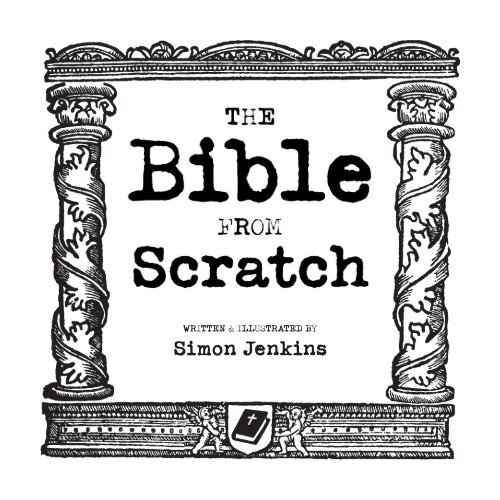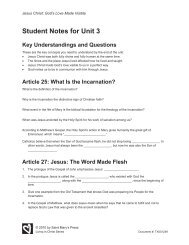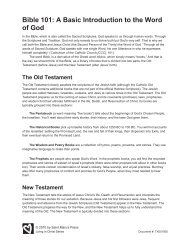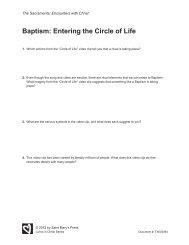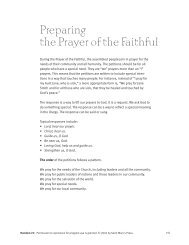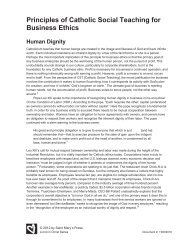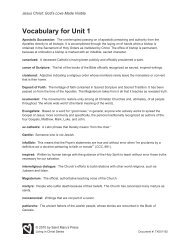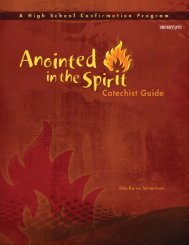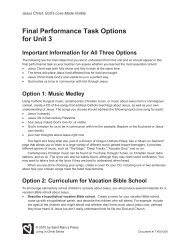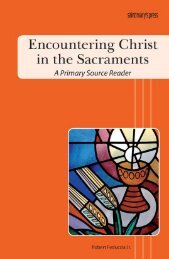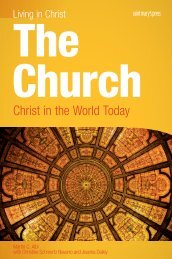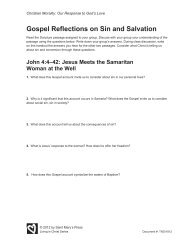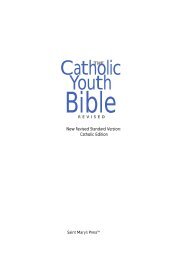Simon Jenkins - Saint Mary's Press
Simon Jenkins - Saint Mary's Press
Simon Jenkins - Saint Mary's Press
Create successful ePaper yourself
Turn your PDF publications into a flip-book with our unique Google optimized e-Paper software.
WRITTEN & ILLUSTRATED BY<strong>Simon</strong> <strong>Jenkins</strong>
Genuine recycled paper with 10% post-consumer waste. 5118300Text and images copyright © 2004 <strong>Simon</strong> <strong>Jenkins</strong>. Original edition publishedin English under the title The Bible from Scratch by Lion Hudson plc, OxfordEngland. Copyright © 2005 Lion Hudson plc 2005.The Bible from Scratch Catholic Edition, copyright © 2006 by <strong>Saint</strong> Mary’s <strong>Press</strong>,Christian Brothers Publications, 702 Terrace Heights, Winona, MN 55987-1318,www.smp.org. All rights reserved.The publishing team included Brian Singer-Towns, development editor; Gary Dreierand Lorraine Kilmartin, reviewers; prepress and manufacturing coordinated by theprepublication and production services departments of <strong>Saint</strong> Mary’s <strong>Press</strong>.Printed in CanadaPrinting: 9 8 7 6 5 4 3 2 1Year: 2014 13 12 11 10 9 08 07 06ISBN 13: 978-0-88489-940-2ISBN 10: 0-88489-940-3AcknowledgmentsScripture quotations from the Good News Bible published by The Bible Societies/HarperCollins Publishers, copyright © 1966, 1971, 1976, 1992 American BibleSociety.Scripture quotations from the Holy Bible, New International Version, copyright ©1973, 1978, 1984 International Bible Society. Used by permission of Zondervanand Hodder & Stoughton Limited. All rights reserved. The “NIV” and “NewInternational Version” trademarks are registered in the United States Patent andTrademark Office by International Bible Society. Use of either trademark requiresthe permission of International Bible Society. UK trademark number 1448790The Scripture quotations contained herein are from the New Revised StandardVersion Bible: Catholic Edition copyright © 1993 and 1989 by the Division ofChristian Education of the National Council of the Churches of Christ in the U.S.A.All rights reserved.”Illustration of Martin Luther King on p. 129 by David Jackson, and image of Jesusof p. 206 used by permission of the Churches Advertising Network.
What’s this?What’s this? The Bible explained in cartoons?Whatever would Moses say? Or Habakkuk? WouldElijah have burned it? And would Paul turn inhis catacomb to see his life’s work reduced to afew scribbles?Hopefully not. The Bible’s characters themselvesweren’t shy about using different methods ofcommunication to get across what they hadto say. Jeremiah smashed crockery. Ezekielperformed weird, one-man plays. David sangsongs. Nathan told a trick story. Jesus talked inpictures.And this drive to popularize has sometimessurfaced in the history of the church, too.St Augustine, heavyweight theologian thoughhe was, took time out to compose pop songs toattack the heretics. And John Calvin, no less,wrote Christian lyrics to Genevan jigs.This book is humbly offered in the same spirit.It’s intended as a beginner’s guide to the GoodBook, something to help readers start their ownexplorations in the Bible.Some thank yous are due: first, to Talitha, mydaughter, for keying in all the handwritten textfrom the original 1987 edition of the book.Also to Nathan, my son, for making the graffitigraphic on page 108. And to Steve Tomkins,for reading the original text and makingboth serious and mischievous suggestions forimproving it.I also owe a debt of love and gratitude to DavidAlexander, whose creativity and encouragementduring my time as an editor at Lion Publishingbrought this book into being.<strong>Simon</strong> <strong>Jenkins</strong>
Inside the Biblefrom ScratchBig, black book 9Around the Bible in 30 days 21Old TestamentIntro to the Old Testament 26MosesThe first five books of the Bible haveMoses as their starring character andthe Exodus as their main eventIntro 52Genesis 54Creation 55Abraham 56Abraham & Sarah's travels 58Joseph 59Exodus 60The great escape 61Moses 62The Exodus 6410 Commandments 65Leviticus 66Numbers 67The ark 68Deuteronomy 69Highlights 70Historical BooksBooks telling the story of theIsraelites, from their arrival inCanaan to their forced exile inBabylon... and back againIntro 72Joshua 74Judges 75Deborah 76Samson 77Ruth 7812 tribes 791 & 2 Samuel 80Samuel 82King Saul 83David’s soap 84Solomon 851 Kings 86Elijah 87Kings of Israel 88Kings of Judah 89Baal 902 Kings 91The Exile 921 & 2 Chronicles 93Ezra 94Nehemiah 95Disputed books 96Tobit 98Angels 99Judith 100Esther 1011 Maccabees 1022 Maccabees 103PoetryA short section of books withpoetry, songs, proverbs and deepstuff about life, death, theuniverse, etc.Intro 106Job 108The Temple 109
LettersIntercepted mail from the firstChristian churches, completewith revealing, embarrassingand inspiring momentsIntro 220Romans 222Paul the traveller 224Who wrote what? 2251 Corinthians 2262 Corinthians 229Paul arrives in Europe 230Galatians 232Ephesians 234Philippians 236Colossians 2381 Thessalonians 240Letter-writing 2412 Thessalonians 2421 Timothy 2432 Timothy 244Paul: his last years 245Titus 246Philemon 247Hebrews 248James 2501 Peter 2512 Peter 2521, 2 & 3 John 253Jude 254The EndThe Bible’s showstopping ending,with trumpets, giant choirs, thecurtain drawn back on heaven,and every tear wiped awayRevelation 256The 7 churches 258Understanding it 2598 THE BIBLE FROM SCRATCH
Big, black bookOnce upon a time, the Bible was a big black book with goldenedgedpages that required a course in bodybuilding before youcould lift it off the shelf.In recent times, though, the Bible’s been repackaged and hassunsets and puppy dogs and other marketing-friendly pictures onthe cover, and no longer weighs a ton. But even though it nowlooks like any other bestseller, the Bible still stands out as beinga book unlike any other.For a start, it was produced by two of the world’s big faiths: Judaismand Christianity. You can see this in the way the Bible is structuredinto two “halves”: the Old Testament and the New Testament. TheOld half contains the scriptures (holy writings), of Judaism, whileChristians regard both Old and New as their scriptures.On top of that, a third world faith – Islam – also regards the Bibleas a holy book, although Muslims believe that the Bible has beencorrupted and is inferior to the Qu’ran.Books, chapters and versesWhen you buy a Bible, you’re not buying just one book, you’rebuying 73 books rolled into one. Take a look at the contents pageof the Bible, and you’ll find all 73 books listed, some with namesthat give a clue to what they’re about, such as Kings, Song ofSolomon and Revelation, but most with the names of the peoplesaid to have written them, such as Matthew, Mark, Luke and John.The word “testament” means“agreement”. The Bible’s first halfcenters on the agreement Godmade with Moses and Israel at MtSinai, and the second half on theagreement God made available to allpeople through the death of JesusChrist. The Old Testament contains46 books, while the New Testamentis smaller, with 27 books.THE BIBLE FROM SCRATCH9
The Bible was divided into chaptersin the 13th century by StephenLangton, who went on to becomeArchbishop of Canterbury. It wasonly broken down into verses afterthe invention of printing.Robert Stephanus created the versesof the New Testament in the 1550s,and legend has it that he choppedit all up while riding on horsebackbetween Paris and Lyon... whichmay explain why some of the breakshappen in unexpected places.These books were written, edited and collected into the thickvolume we know as the Bible over about 1,500 years. During thattime, all sorts of material was gathered together: songs, legalcontracts, letters, stories, riddles, official histories, poems, familytrees and so on. This makes the Bible like a huge warehouse witha vast variety of curious and compelling bits and pieces hiddenaway on its shelves.The chart opposite shows how these different materials arestructured in the Bible.Weighing in at close to a million words, the Bible can seemlike a daunting read. But as well as being broken down intotwo testaments and 73 books, each book is broken down intochapters, and each chapter into verses of a sentence or two each.All of which helps you feel you’re actually getting somewherewhen you start reading it.Ancient blockbusterThe Bible also stands out for its enduring popularity. Have youever thought how curious it is that the Bible is still such abestselling and much-read book? The ink on the pages of theBible has been dry for almost 2,000 years – that’s when the lastwriter laid down his pen – and yet it’s still being read all over theworld today. By any terms, that’s a huge achievement.In the last 150 years alone, an estimated 1.6 billion Bibles havebeen printed. And it’s been translated into no fewer than 3,000languages.Just think about it. This is an ancient book. How many people goout and buy 2,000-year-old texts from the ancient world for theirreading pleasure? ... Sophocles, Plato, the Epic of Gilgamesh,Plutarch, Livy, Ovid... Anyone for Euripides?10 THE BIBLE FROM SCRATCH
How the Biblefits togetherIts books arein four mainsections...The Old Testamentis mostly writtenin Hebrew andhas 46 booksBooks giving theLaw of Moses(Genesis toDeuteronomy)The Bible has twomajor sections...Its books are in threemain sections...The New Testamentis written in Greekand contains27 booksThe four Gospels,telling the story ofJesus (Matthewto John)...Books telling the storyof Israel and Judah(Joshua to 2 Maccabees)... plus the bookof Acts, which isabout the spread ofJesus' message.Books with songs,poetry, philosophyand wise sayings(Job to Sirach)The letters of Paul,Peter, John and othersto the first churches(Romans to Jude)The book of Revelation,about things to comeTHE BIBLE FROM SCRATCHBooks of protest andprophecy written in thelast centuries before Christ(Isaiah to Malachi)11
Things were different in the daysof the Bible... for example, thehaircuts...And the Bible isn’t just ancient, it’s oriental. It’s not a modern,western book. That’s why it can sound foreign to us at firstreading. It’s full of details such as what to do if you get mildewon your tent flap, how to carry out the interior design of atemple, or the best way to handle a runaway slave.But even though this book comes to us out of the distant past,it still makes compulsive reading. Part of the reason is that wecan see our reflection in the book’s characters and stories. This ispart of the Bible’s power – its stories speak to us. It’s one of thereasons why we break the habit of a lifetime and read a 2,000-year-old book.The Bible is a book that is endlessly retold – especially by beingtranslated into new languages. Aside from the huge translationprojects that have brought the Good Book to remote tribespeoplearound the world, the most famous bits of the Bible have alsobeen “translated” for Cockneys, black rappers, Glaswegians, andeven extraterrestrials such as the Klingons.Here’s the creation of heaven and earth from Genesis chapter 1,according to The Black Bible Chronicles, a ‘hip and holy’ versionwritten for the streets of the South Bronx...Now when the Almighty was first down with Hisprogram, He made the heavens and the earth. Theearth was a fashion misfit, being so uncool anddark, but the Spirit of the Almighty came downreal tough, so that He simply said, ‘Lighten up!’And here’s the same passage in A Glasgow Bible...It wis a lang time ago, right enough – thoosans anthoosans o years since. There wis nuthin whaurthe earth is the noo – absolutely nuthin at aw.12 THE BIBLE FROM SCRATCH
‘Weell noo,’ God says tae himsel wan day, ‘I’ll fix awee bit dod o land – doon there.’Meanwhile, one of the gentlest and best-loved passages from theOld Testament is now available to the most bloodthirsty beingsin our neck of the Galaxy – the Klingons. Psalm 23 (‘The Lord ismy shepherd’), brought to us courtesy of the Klingon LanguageInstitute, begins...QorghwI’wI’ ghaH joH’a’’e’ jIHvaD Dach pagh.For those not fluent in Klingon, this roughly translates as‘Caretaker-my he-is great-lord, for-me it-lacks nothing.’God and his ghost-writersThe true focus of the Bible’s power is not just its ability totell a good story, or last forever as a bestseller, or engage ourimagination. Its power lies somewhere else. And it’s this: the Bibleshows us God. This isn’t just any old book. Christians believe the73 books of the Bible are uniquely the word of God: that is, Godspeaks to us through them and shows us what kind of God he is.Christians believe the Bible is the revelation of God. They saywe can’t discover the truth about God simply by thinking hardor long enough. We can only know God when he makes the firstmove. God reveals himself most fully to us in the coming of Jesusinto the world, and the written word of God, the Bible, is part ofthat revelation.The Catholic Church puts it this way, in a teaching documentcalled Dei Verbum (or Divine Revelation): “The books of Scripturefirmly, faithfully and without error teach that truth which God,for the sake of our salvation, wished to see confided to theSacred Scriptures.”THE BIBLE FROM SCRATCH13
How does God do this? One word the Bible uses to describe the“how” of revelation is the word inspired. Here’s the famousquotation which is often used when people talk about the Godgivenstatus of the Bible...All scripture is inspired by God and isuseful for teaching, for reproof, for correction,and for training in righteousness, so that everyonewho belongs to God may be proficient, equippedfor every good work.2 Timothy 3:16The Greek word used here for “inspired” literally means “Godbreathed”.Scripture is God breathing out. Just as when we speak,we are breathing out, so God breathes out his word from thedepths of his being. This implies that the Bible has its origins inGod himself.Here’s another famous quotation about God and inspiration...The Greek word for “inspired” istheopneustos: theo = “God” andpneustos = “breathed”. We get theword “pneumatic” from thesame Greek word, as inpneumatic tires oncars and bikes.Prophecy never had its originin the will of man...(that is, it wasn’t people making theories about God)... but men spoke from God as they werecarried along by the Holy Spirit.2 Peter 1:2114 THE BIBLE FROM SCRATCH
The Greek word for “carried along” is the same word that isused to talk about a sailing ship being blown along by the wind.There’s the same idea of breath or wind here.These verses, plus others in the Bible, lead Christians to believethat the writers of the Bible were moved by God’s Spirit, so thatwhat they wrote was inspired by God. That’s why many Christianslook at the Bible as a key authority for what they believe andhow they should live.These descriptions work well in talking about the experience ofthe most striking characters in the Old Testament – people suchas Moses or Elijah, who received direct revelations from God.Here’s Jeremiah, for example, one of the greatest prophets...Then the Lord reached out his hand andtouched my mouth and said to me, ‘Now,I have put my words in your mouth...’Jeremiah 1:9And here’s Ezekiel, in his famous-but-bizarre vision of the valleyof dry bones...Then the Lord said to me, “Prophesy tothese bones and say to them, ‘Dry bones!Hear the word of the Lord!’”Ezekiel 37:4In these examples, God breaks in like a radio message and tellsthe prophet what to say. Many writers in the early days of thechurch looked at verses such as these and talked about the Bible’sTHE BIBLE FROM SCRATCH15
writers being like musical instruments played by the Spirit. Theinstruments might be human, but the music was perfect and wasGod’s.Other Christian writers haven’t been so happy with that pictureof God strumming his guitar or tootling his flute, as it suggeststhe prophets were completely passive, and maybe even possessed,when they gave their prophecies. To change the image, it’s as ifGod was holding the remote control and the prophet had no sayin what was happening.How it didn't happen...remote-controlledprophetsMost Christian commentators have resisted the idea that theBible was dictated by God, or handed down from a passing cloud.They’ve balanced the divine side of the Bible by also stressing itshuman side – that it was written by real, messy human beings. Inthe past century, Christians have talked more about the humanwriters of the Bible and have come to appreciate and even enjoythe fact that because they were human beings, their likes anddislikes, their sense of humor and even their bad grammar comesacross in what they wrote.Just as Christians believe Jesus was fully God and fully ahuman being, so the Bible is inspired by God but is also ahuman production. It didn’t drop out of heaven one day. God’sinspiration had to negotiate with the very imperfect characters ofDavid, Mark, Solomon, Paul and the other writers.Even though the Bible has plenty of instances of prophets beingtold, ‘Hit them with this!’ by God, there are huge stretches ofthe book where this just doesn’t happen. Large chunks of theBible don’t have any dramatic, supernatural revelations, in whichpeople hear voices from heaven, or get told what to say, or seefantastic visions.16 THE BIBLE FROM SCRATCH
Take the book of Esther, for instance, which in some versionsdoesn’t even mention the word “God”. Or the hundreds of wisesayings and riddles in the book of Proverbs. Or the long familytree which takes up most of the first chapter of Matthew’s Gospel.What about these writings? Were they “breathed out” by God– and if so, how were the writers inspired?Some Christian thinkers have suggested that God’s Spirit wasflexible in the way he inspired the Bible’s different writers. Hemight have spoken a direct word in the ear of a prophet, theysay, but for King Solomon, the Spirit gave him such a strong doseof wisdom that his proverbs were what God wanted to be said. Orin the case of Luke, who carefully collected and researched thestory of Jesus, Christian thinkers have argued that the Holy Spiritguided the process so that Luke’s Gospel is the word not just ofLuke, but of God, too.So is it true?How much can we trust the Bible? Can we believe in what it says?Is it possible the Bible contains mistakes, and if so, what doesthat do to our faith? Do Christians have to accept everythinghappened just as it says – even the stories which seem a bitimplausible – or is there some room for negotiation?Some Christians believe the Bible is 100 percent free from errorsof any kind, saying every single word in the original manuscriptswas inspired by God. As one preacher put it: “God said it, thatsettles it, I believe it!” For many people who hold this view, Godcreated the world in six, 24-hour days, because that is what theyread straight off the page in Genesis chapter 1.This view of the Bible has been hugely popular among someChristians around the world. In its most extreme form, it isThe prize for the strangest and yetmost precise dating of the momentof creation goes to ArchbishopJames Ussher, Anglican Primate ofIreland. In 1650, he declared thathis calculations showed the creationto have happened at 12 noon on23 October 4004 BC. This was basedpartly on countingthe ‘begats’in the Bibleand on asymbolicnumberingscheme.THE BIBLE FROM SCRATCH17
antagonistic to the findings of modern science, and CharlesDarwin in particular. This is the view which comes closest tosaying the human writers of the Bible were mere keyboards whichGod used to key in the messages he wanted, word for word.Catholic Christians, along with many others, are cautious aboutclaiming the Bible is literally true, word for word. The Catholicchurch has some important things to say about the truth of thescriptures. The following points are taken from Dei Verbum (“TheWord of God”), a major teaching document of the Second VaticanCouncil.1. The essentials – the church says the Bible is without errorwhen it talks about the truths God has revealed for our salvation.Here are the words of Dei Verbum...Since everything asserted by the inspired authorsor sacred writers must be held to be assertedby the Holy Spirit, it follows that the books ofScripture must be acknowledged as teachingsolidly, faithfully and without error that truthwhich God wanted put into sacred writings.2. Interpreting wisely – when reading different parts of theBible, it’s important to remember what kind of writing we’relooking at. Some of the writers are recounting history, whileothers are detailing family trees, setting out law codes, writingpoetry, giving prophesy or penning a letter to friends. Thesetypes of writing are different, and they need different ways ofreading, too. So when a poet says...He who dwells in the shelter of the Most Highwill rest in the shadow of the Almighty.Psalm 91:118 THE BIBLE FROM SCRATCH
... it doesn’t mean that God literally casts a shadow on theground! We need to read poetry as poetry and understand how ituses metaphors and images. As Dei Verbum says...For the correct understanding of what the sacredauthor wanted to assert, due attention must bepaid to the customary and characteristic styles offeeling, speaking and narrating which prevailedat the time of the sacred writer, and to thepatterns men normally employed at that period intheir everyday dealings with one another.We also need to understand that our modern eyes are lookingat an ancient text. The biblical writers had a very differentunderstanding of science, and their culture was very differentfrom ours, too. This means that what looks to us like a mistakein the Bible is sometimes down to the writer’s differentunderstanding of science, history or culture. Hopefully, TheBible from Scratch will help explain some of the big differencesbetween the Bible writers and us, and will help you read andunderstand them better.3. The Bible and Tradition – Catholic Christians have sacredTradition in helping to understand the Bible. In fact, sacredTradition and the Bible go hand in hand in communicatingGod’s revelation to us. The church believes it continues to beempowered by the Holy Spirit to preserve, teach and interpret theBible in every new generation.On a practical level, this means there are plenty of resources tohelp us with any questions we have about the Bible, includingCatholic books and websites, and parish priests and teachers. Weshouldn’t be afraid to use the rich resources the church has tooffer us.THE BIBLE FROM SCRATCH19
Handle with careIf you believe that the Bible came from God – however youthink that happened – then you should approach reading itwith care. God is on the other end of the line, and God is hugelyunknown, mysterious, creative and wild. You simply do not knowwhat might happen if you start reading with an open mind andexpectant heart.Here’s some good advice from a 7th-century Christian, Isaac ofNineveh, about what to do before opening this wonderful book...Never approach the words of the mysteries thatare in the scriptures without praying and askingfor God’s help. Say, “Lord, grant me to feel thepower that is in them.” Reckon prayer to be thekey that opens the true meaning of the Scriptures.– Isaac of Nineveh20 THE BIBLE FROM SCRATCH
Around the Biblein 30 daysThis short reading course is designed to help you get startedin the Bible. Or if you’re stuck, to help you get restarted. Itintroduces 30 significant Bible passages that will take youquickly from Genesis to Revelation. Just think. If you read onea day, it’ll take you a month. Unless it’s February. 1. ‘Let there be light!’Genesis 1:1 – 2:4The Bible opens with a majesticdescription of God as creator ofeverything. Humankind is seen asthe peak of God’s creation. 2. The Garden of EdenGenesis 2:5 – 3:24This second creation accountfocuses on Adam and Eve. Chapter3 describes ‘The Fall’, when God’sgood creation is spoiled. 3. God tests AbrahamGenesis 22:1–9Abraham (see page 56) was thefather of the Jewish race. Here Godtests his loyalty severely. 4. The burning bushExodus 2–3Centuries after Abraham, theIsraelites are slaves in Egypt. Moses(see page 62) is here called by Godto help free the slaves. 5. The great escapeExodus 14The Israelites slaves have been setfree. But they are pursued by theEgyptians and trapped against thesea (see page 61). 6. At Mt SinaiExodus 19:1 – 20:21Moses’ people reach Mt Sinai inthe desert. Here God makes anagreement with them and givesthem his law. 7. ‘Be holy...’Leviticus 19In this chapter of laws, God wantshis people to reflect his character.The laws have a special concern forthe poor and powerless.THE BIBLE FROM SCRATCH21


